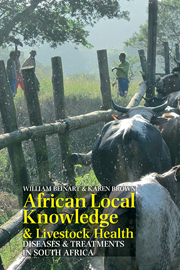Book contents
- Frontmatter
- Contents
- Acknowledgements
- Abbreviations
- Names of Common Diseases
- List of Maps, Photographs & Tables
- 1 Introduction: African Local Knowledge & Veterinary Pluralism
- 2 Ticks, Tick-borne Diseases & the Limits of Local Knowledge Introduction
- 3 ‘The Grave of the Cow is in the Stomach’: Environment & Nutrition in the Explanation & Prevention of Livestock Diseases
- 4 Transhumance, Animal Diseases & Environment
- 5 Plants & Drugs: Medicating Livestock
- 6 Medicinal Plants: Their Selection & their Properties
- 7 Animal Health & Ideas of the Supernatural
- 8 Gender, Space & the Supernatural
- 9 Conclusion
- Appendices
- Select Bibliography
- Index
3 - ‘The Grave of the Cow is in the Stomach’: Environment & Nutrition in the Explanation & Prevention of Livestock Diseases
Published online by Cambridge University Press: 05 December 2013
- Frontmatter
- Contents
- Acknowledgements
- Abbreviations
- Names of Common Diseases
- List of Maps, Photographs & Tables
- 1 Introduction: African Local Knowledge & Veterinary Pluralism
- 2 Ticks, Tick-borne Diseases & the Limits of Local Knowledge Introduction
- 3 ‘The Grave of the Cow is in the Stomach’: Environment & Nutrition in the Explanation & Prevention of Livestock Diseases
- 4 Transhumance, Animal Diseases & Environment
- 5 Plants & Drugs: Medicating Livestock
- 6 Medicinal Plants: Their Selection & their Properties
- 7 Animal Health & Ideas of the Supernatural
- 8 Gender, Space & the Supernatural
- 9 Conclusion
- Appendices
- Select Bibliography
- Index
Summary
Introduction
Richard Molebalwe from Bethanie (near Brits, North West Province) told us that ‘the grave of the cow is in the stomach’. He was not alone in regarding the stomach and the digestive organs as the key to good health. Stockowners often described the primary symptoms of sickness as lack of appetite, diarrhoea or constipation. Many farmers carried out post-mortems to determine the cause of death before preparing the meat for consumption. They examined the state of the gallbladder — was it inflamed or were the fluids an unusual colour? Were the intestines and stomach congested or blocked? Were the inner linings of the gut smooth or rough? Was the digestive tract full of worms, stealing the food and sapping the animal of its life force? Good health, by contrast, was manifest in a rapacious appetite and weight gain resulting in a shiny coat and gleaming eyes. An aesthetically attractive cow fed well and defecated regularly. Healthy cattle bred freely and calved with abandon. A stockowner's wealth was tied to the health of his animals' innards.
Consequently, diet was at the heart of understandings about wellness and sickness. Stockowners believed many diseases, but in particular frequently encountered infections such as gallsickness and blackquarter, emanated from the veld. Poor grasses, watered by too much or too little rainfall portended disaster for a flock or herd. In North West Province, worms and toxic flora parasitised the grasslands and brought doom to the unwary animal that ingested them.
- Type
- Chapter
- Information
- African Local Knowledge and Livestock HealthDiseases and Treatments in South Africa, pp. 68 - 108Publisher: Boydell & BrewerPrint publication year: 2013



